APIC 2000: Needle safety, skin care, and antimicrobial products attract attention at infection control exhibition
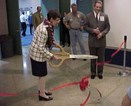
By Rick Dana Barlow
MINNEAPOLIS – With 14 states legally mandating the use of needle-safety and sharps protection devices in healthcare facilities, it should come as no surprise what popular product category turned the heads of infection control professionals migrating up and down the exhibition aisles here last night at the 2000 Annual Educational Conference and International Meeting of the Association for Professionals in Infection Control and Epidemiology Inc.
Nearly 3,100 registered attendees, according to APIC's tabulation, roamed the densely packed exhibit hall Sunday evening for 90 minutes on the show's opening night to sample the wares on display by more than 130 vendors. The educational conference officially began this morning.
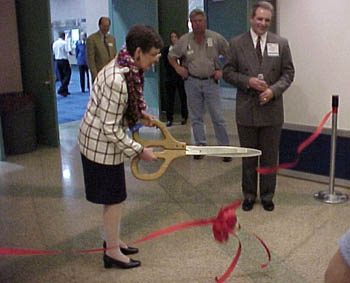

Twenty-three of the total number of exhibiting vendors comprised manufacturers of needle-safety devices, such as self-sheathing syringes, needle-free intravenous systems, and sharps disposal units.
Qlicksmart Blade Removal Systems (Orlando, FL) demonstrated how clinicians can use its single-handed scalpel blade remover. They simply insert a common blade from most size No. 3, No. 4, No. 5, No. 7, and No. 9 scalpel handles onto the landing pad of the unit, push the handle into a flask next to the landing pad until they hear a click and then remove the handle. The blade remains contained inside the unit, which can hold 100 before it's full. Once the unit reaches its fill limit, a shut-off mechanism covers the opening. The product comes with a mounting template for a bench or a wall. The company launched the product in its home country, Australia, in May 1998, gaining Food and Drug Administration marketing clearance roughly a year ago.

B. Braun Medical Inc. (Bethlehem, PA) developed its new Introcan Safety IV Catheters for healthcare facilities in California where the first state-legislated needle-safety device mandate went into effect last year. At APIC 2000, company representatives said they were rolling it out to the rest of the nation's hospitals and also trying to penetrate the non-acute care market. The Introcan Safety IV Catheter features a safety clip, a passive engineering control pre-assembled inside the catheter hub. When the clinician pulls the needle bevel from the catheter hub, the safety clip automatically engages, attaching itself to the bevel. B. Braun also promoted its Safsite needle-free IV system and its Ultrasite positive pressure capless valve.
Bio-Plexus Inc. (Vernon, CT) showcased its Punctur-Guard blood collection needle, which features a safety mechanism that is activated before the clinician removes the needle from the patient.
Owen Mumford Inc. (Marietta, GA) promoted its line of capillary lancing, drug delivery and injection devices, including the Autopen and Autoject self-injection devices, Unifine Pentips Pen Needles, Unilet lancets, Autolet lancing devices and Unistik single-use lancing devices.
Retractable Technologies Inc. (Lewisville, TX) demonstrated its VanishPoint automated retractable needle product. After a clinician completes a blood draw or an injection, the needle automatically retracts into the barrel of the safety syringe.
The only product category that rivaled needle-safety devices in sheer number of exhibiting vendors was antimicrobial skin care products. Twenty-three suppliers demonstrated variations of hand scrubs and rinses designed to kill germs while soothing and conditioning skin. One of the common excuses for nurses not washing their hands—a galling infection control problem that persists—is that the detergents and soaps typically used dries their hands, causing them to chap.
Ecolab Professional Products Division (St. Paul, MN) encouraged infection control professionals to sample its year-old Quik-Care Healthcare Personnel Hand Rinse and Antimicrobial Foam. The waterless, foamed antimicrobial hand rinse is formulated with 62.5% ethyl alcohol and emollients to help moisturize and protect the skin. Ecolab promoted Quik-Care as "ideal for situations where there is simply no time or place to wash with soap and water." In fact, Ecolab received an FDA nod about three months ago to market Quik-Care as a waterless surgical hand scrub, too, according to Mark Messervey, account executive at the booth.
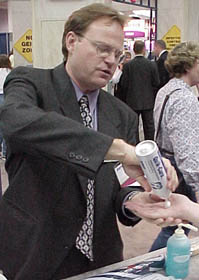
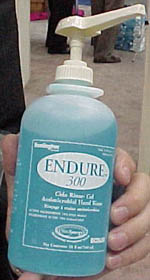
Ecolab debuted its SkinSynergy program of skin care products at APIC 1999 in Baltimore but has since expanded the Huntington brand Endure products. New to the line is the Endure 50 lotion skin cleanser and antibacterial skin cleanser, the Endure 300 waterless antimicrobial hand rinses and the soon-to-debut Endure 350 waterless antimicrobial surgical scrub with a six-hour residual. Ecolab's Messervey emphasized that the market is moving quickly to brushless, waterless scrubs in the operating room and that his company is well-positioned to meet that demand.
GOJO Industries Inc. (Akron, OH) displayed its Provon and Purell brands of hand hygiene and skin care products along with its dispensing systems.
AMS Midlands Inc. (St. Louis) encouraged infection control professional attendees to take its automated handwashing and drying sink for a test drive. The company's Wallgate CME is a recessed, molded handwasher and dryer that automatically dispenses liquid soap, heats water and dries with sanitary high-power hot air. Although AMS Midlands promoted two different versions of the unit, one model, which sports a "cultured granite" high-density polymer front fascia available in six colors, allows users to perform the function automatically via infrared sensor activation. The other model, with a stainless steel front, calls for users to push one of three buttons near the floor of the unit to dispense soap, water or hot air for drying. That model awaits FDA marketing clearance, according to AMS Midlands' Dan Wheeler. Currently, the company sells it in the United Kingdom and Europe.
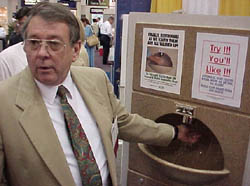

Either unit can be programmed for specified washing, rinsing and drying times, Wheeler said. In fact, because the unit only heats the water during a wash cycle and water usage is minimal (typically less than ½ liter per cycle), utility costs decrease even as good handwashing practices are encouraged, he noted.
Arjo Inc. (Roselle, IL) demonstrated its Tornado flusher disinfector for cleaning and disinfecting bedpans, urinals and other contaminated receptacles without manual labor.
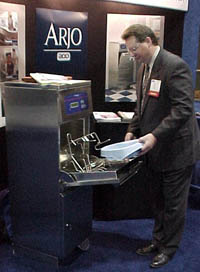
The Tornado, which came to the United States in mid-1998 after being sold for 10 years in Europe, comes fitted with a multifunctional rack that can hold most common types of containers, including oval bedpans, urine bottles, toilet buckets, American bedpans, insert baskets, and wash basins. The Tornado's microcomputer controls the program, control, service, testing, and statistical functions. An easy-to-read display allows users to automatically program the type of receptacle to be washed. An entire cycle takes three-to-seven minutes depending on the settings used.
Dornach Medical Systems Inc. (Riverside, MO) demonstrated its Red-Away system, which is designed to reduce red-bag waste typically sent to incinerators and landfills, through its patented reusable liquid waste collectors and disposal unit.
Ecolab also showcased its Huntington brand Cida-Steryl 28 II glutaraldehyde solution for sterilizing and high-level disinfecting reusable medical devices. Cida-Steryl 28 II is a 3% alkaline-based glutaraldehyde solution can remain effective for 28 days once it's activated. It provides intermediate-level disinfection in five minutes, high-level disinfection in 25 minutes and sterilization in 10 hours of soaking. Ecolab also packaged the product in a new ergonomically designed anti-splash bottle with a built-in activator holder instead of one molded to the side of the gallon container. Ecolab's Mark Messervey said the new container "doesn't glug or splash when you pour it."
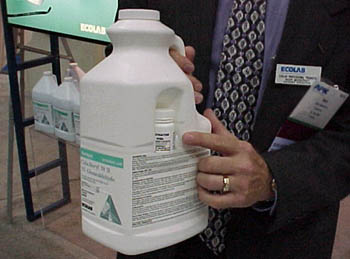
Source: Hospital Network.com, sister website to Medical Design Online.
